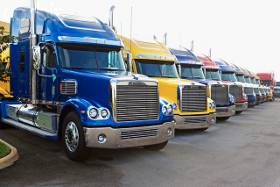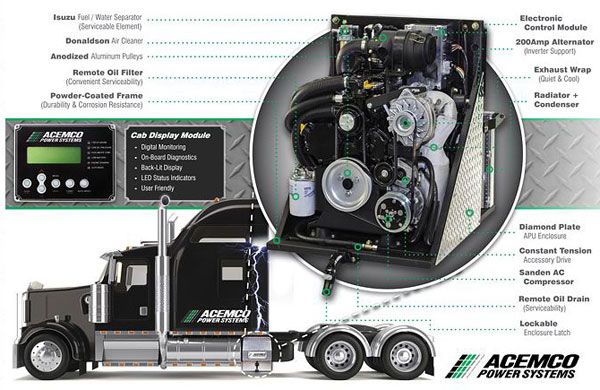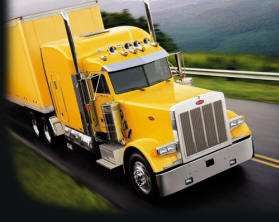Schneider
Topic 20202 | Page 2
Of course my backing still sucked throughout that week and to this day, I still can't do a 45° back to save my life, but the opportunity for help was there.
Once you are set up, line up your drives with the V in the middle of the landing gear, then steer the opposite direction. When you get the tractor straight sith the trailer, you should be in the hole.
Backing is always easier if you use reference points on the truck and trailer. It's all about the angles between the truck and trailer.

I had a phone interview last week with a Schneider's recruiter from across the border. It is very different from the US side from what I've been reading on TT. 500 miles radius from terminal , eastern seaboard at .37/mile first year then .39-1/2 for year 2,3. $10 each border crossing. Different choices for home time. 6 days out 3 days home 14 out 7 home. In both options you have to take your stuff with you home. Only Manuel trucks to start. Options for your own truck are 11out 3 home or 12 out 2 home or you can stay out longer if you want. Cab has no fridge, no microwave, no apu , no electric connections. It only has lighter connections. Training first week mostly paper work and some yard training , second week out with trainer for local deliveries, third week more paper work Qualcomm, logbook and in cab training then road test.
I need alot more training then this for me to be comfortable.
While you do only get 1 week doing actual deliveries while training, you can, and definitely should, ask for more training if you feel like you didn't get enough.
I was trained by a chicago local. I never went further than 150m from the Gary OC. Being hired on as Midwest regional , I didn't feel like I got the necessary training I needed, so I asked for another week. I was paired with a driver who did Midwest regional and I felt a lot more comfortable afterwards. It also helped considering he constantly kept saying, "I don't know why you're still in my truck. You're doing just fine." Of course my backing still sucked throughout that week and to this day, I still can't do a 45° back to save my life, but the opportunity for help was there.
Thanks, it's good to know. I didn't go to a training school, I did a non vocational course training in yard. You basically pay as you drive, training is very basic as trainers spend more time on cell phone then training you. All the study is on you, you only go there to drive.
That was before July 1th. Now law changed you need minimum 107 hours total training. I was able to pass my road test with less then 10 driving hours.
So I need to have real training with a real trainer for at least a few weeks driving only. I might go back to school for a refresher course since I already have my CDL.
CDL:
Commercial Driver's License (CDL)
A CDL is required to drive any of the following vehicles:
- Any combination of vehicles with a gross combined weight rating (GCWR) of 26,001 or more pounds, providing the gross vehicle weight rating (GVWR) of the vehicle being towed is in excess of 10,000 pounds.
- Any single vehicle with a GVWR of 26,001 or more pounds, or any such vehicle towing another not in excess of 10,000 pounds.
- Any vehicle, regardless of size, designed to transport 16 or more persons, including the driver.
- Any vehicle required by federal regulations to be placarded while transporting hazardous materials.
Logbook:
A written or electronic record of a driver's duty status which must be maintained at all times. The driver records the amount of time spent driving, on-duty not driving, in the sleeper berth, or off duty. The enforcement of the Hours Of Service Rules (HOS) are based upon the entries put in a driver's logbook.
Terminal:
A facility where trucking companies operate out of, or their "home base" if you will. A lot of major companies have multiple terminals around the country which usually consist of the main office building, a drop lot for trailers, and sometimes a repair shop and wash facilities.
Regional:
Regional Route
Usually refers to a driver hauling freight within one particular region of the country. You might be in the "Southeast Regional Division" or "Midwest Regional". Regional route drivers often get home on the weekends which is one of the main appeals for this type of route.
Qualcomm:
Omnitracs (a.k.a. Qualcomm) is a satellite-based messaging system with built-in GPS capabilities built by Qualcomm. It has a small computer screen and keyboard and is tied into the truck’s computer. It allows trucking companies to track where the driver is at, monitor the truck, and send and receive messages with the driver – similar to email.APU:
Auxiliary Power Unit
On tractor trailers, and APU is a small diesel engine that powers a heat and air conditioning unit while charging the truck's main batteries at the same time. This allows the driver to remain comfortable in the cab and have access to electric power without running the main truck engine.
Having an APU helps save money in fuel costs and saves wear and tear on the main engine, though they tend to be expensive to install and maintain. Therefore only a very small percentage of the trucks on the road today come equipped with an APU.


Did not start interview with Schneider, going to try and find a local job before committing to a big company. Have an interview and driving exam with a food retailer on Thursday who aren't put off by my inexperience, pay relatively low at £16.65 per hour but I will be home most nights and weekends. If all else fails will get back in touch with Schneider or similar company in a month or so and agree to start with them

I've been with Schneider now for 2 years. I live in Pittsburgh and do the Walmart account out of Wintersville, Oh. They paid for my cdl training and then paid me while I trained for my account out of Indianapolis. Walmart has been an excellent account to start with. Lots of easy backing and no touch freight. I work a 6 on and 2 day off schedule. I made $62k my first year plus I maxed out my tax returns with about $4500 extra for sleeping in my truck. I'm on target for 75k this year. Feel free to contact me if you have any questions. I'm totally willing to show my pay stubs.
CDL:
Commercial Driver's License (CDL)
A CDL is required to drive any of the following vehicles:
- Any combination of vehicles with a gross combined weight rating (GCWR) of 26,001 or more pounds, providing the gross vehicle weight rating (GVWR) of the vehicle being towed is in excess of 10,000 pounds.
- Any single vehicle with a GVWR of 26,001 or more pounds, or any such vehicle towing another not in excess of 10,000 pounds.
- Any vehicle, regardless of size, designed to transport 16 or more persons, including the driver.
- Any vehicle required by federal regulations to be placarded while transporting hazardous materials.
New Reply:
New! Check out our help videos for a better understanding of our forum features

















Preview:








 TT On Facebook
TT On Facebook
While you do only get 1 week doing actual deliveries while training, you can, and definitely should, ask for more training if you feel like you didn't get enough.
I was trained by a chicago local. I never went further than 150m from the Gary OC. Being hired on as Midwest regional , I didn't feel like I got the necessary training I needed, so I asked for another week. I was paired with a driver who did Midwest regional and I felt a lot more comfortable afterwards. It also helped considering he constantly kept saying, "I don't know why you're still in my truck. You're doing just fine." Of course my backing still sucked throughout that week and to this day, I still can't do a 45° back to save my life, but the opportunity for help was there.
Logbook:
A written or electronic record of a driver's duty status which must be maintained at all times. The driver records the amount of time spent driving, on-duty not driving, in the sleeper berth, or off duty. The enforcement of the Hours Of Service Rules (HOS) are based upon the entries put in a driver's logbook.
Terminal:
A facility where trucking companies operate out of, or their "home base" if you will. A lot of major companies have multiple terminals around the country which usually consist of the main office building, a drop lot for trailers, and sometimes a repair shop and wash facilities.
Regional:
Regional Route
Usually refers to a driver hauling freight within one particular region of the country. You might be in the "Southeast Regional Division" or "Midwest Regional". Regional route drivers often get home on the weekends which is one of the main appeals for this type of route.
Qualcomm:
Omnitracs (a.k.a. Qualcomm) is a satellite-based messaging system with built-in GPS capabilities built by Qualcomm. It has a small computer screen and keyboard and is tied into the truck’s computer. It allows trucking companies to track where the driver is at, monitor the truck, and send and receive messages with the driver – similar to email.APU:
Auxiliary Power Unit
On tractor trailers, and APU is a small diesel engine that powers a heat and air conditioning unit while charging the truck's main batteries at the same time. This allows the driver to remain comfortable in the cab and have access to electric power without running the main truck engine.
Having an APU helps save money in fuel costs and saves wear and tear on the main engine, though they tend to be expensive to install and maintain. Therefore only a very small percentage of the trucks on the road today come equipped with an APU.